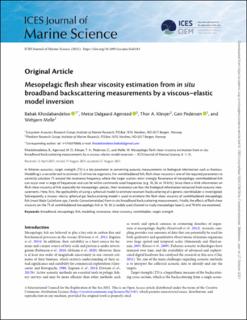| dc.contributor.author | Khodabandeloo, Babak | |
| dc.contributor.author | Agersted, Mette Dalgaard | |
| dc.contributor.author | Klevjer, Thor A. | |
| dc.contributor.author | Pedersen, Geir | |
| dc.contributor.author | Melle, Webjørn Raunsgård | |
| dc.date.accessioned | 2021-11-05T13:04:23Z | |
| dc.date.available | 2021-11-05T13:04:23Z | |
| dc.date.created | 2021-10-26T15:29:45Z | |
| dc.date.issued | 2021 | |
| dc.identifier.citation | ICES Journal of Marine Science. 2021, . | |
| dc.identifier.issn | 1054-3139 | |
| dc.identifier.uri | https://hdl.handle.net/11250/2828180 | |
| dc.description.abstract | In fisheries acoustics, target strength (TS) is a key parameter in converting acoustic measurements to biological information such as biomass. Modelling is a versatile tool to estimate TS of marine organisms. For swimbladdered fish, flesh shear viscosity is one of the required parameters to correctly calculate TS around the resonance frequency, where the target scatters most strongly. Resonance of mesopelagic swimbladdered fish can occur over a range of frequencies and can be within commonly used frequencies (e.g. 18, 38, or 70 kHz). Since there is little information on flesh shear viscosity of fish, especially for mesopelagic species, their resonance can bias the biological information extracted from acoustic measurements. Here, first, the applicability of using a spherical model to estimate resonant backscattering of a generic swimbladder is investigated. Subsequently, a viscous–elastic spherical gas backscattering model is used to estimate the flesh shear viscosity of swimbladdered mesopelagic fish (most likely Cyclothone spp., Family: Gonostomatidae) from in situ broadband backscattering measurements. Finally, the effects of flesh shear viscosity on the TS of swimbladdered mesopelagic fish at 18, 38 (a widely used channel to study mesopelagic layers), and 70 kHz are examined. | |
| dc.language.iso | eng | |
| dc.relation.uri | https://academic.oup.com/icesjms/advance-article/doi/10.1093/icesjms/fsab183/6378058 | |
| dc.title | Mesopelagic flesh shear viscosity estimation from in situ broadband backscattering measurements by a viscous–elastic model inversion | |
| dc.type | Peer reviewed | |
| dc.type | Journal article | |
| dc.description.version | publishedVersion | |
| dc.source.pagenumber | 15 | |
| dc.source.journal | ICES Journal of Marine Science | |
| dc.identifier.doi | 10.1093/icesjms/fsab183 | |
| dc.identifier.cristin | 1948595 | |
| dc.relation.project | Havforskningsinstituttet: 15093 | |
| dc.relation.project | Norges forskningsråd: 309512 | |
| dc.relation.project | EC/H2020/817669 | |
| dc.relation.project | Norges forskningsråd: 280546 | |
| cristin.ispublished | true | |
| cristin.fulltext | original | |
| cristin.qualitycode | 1 | |
